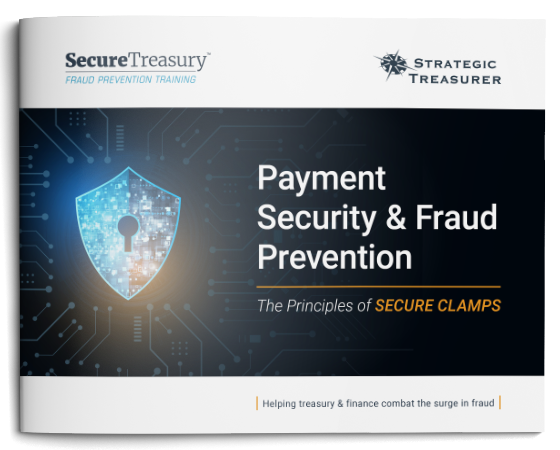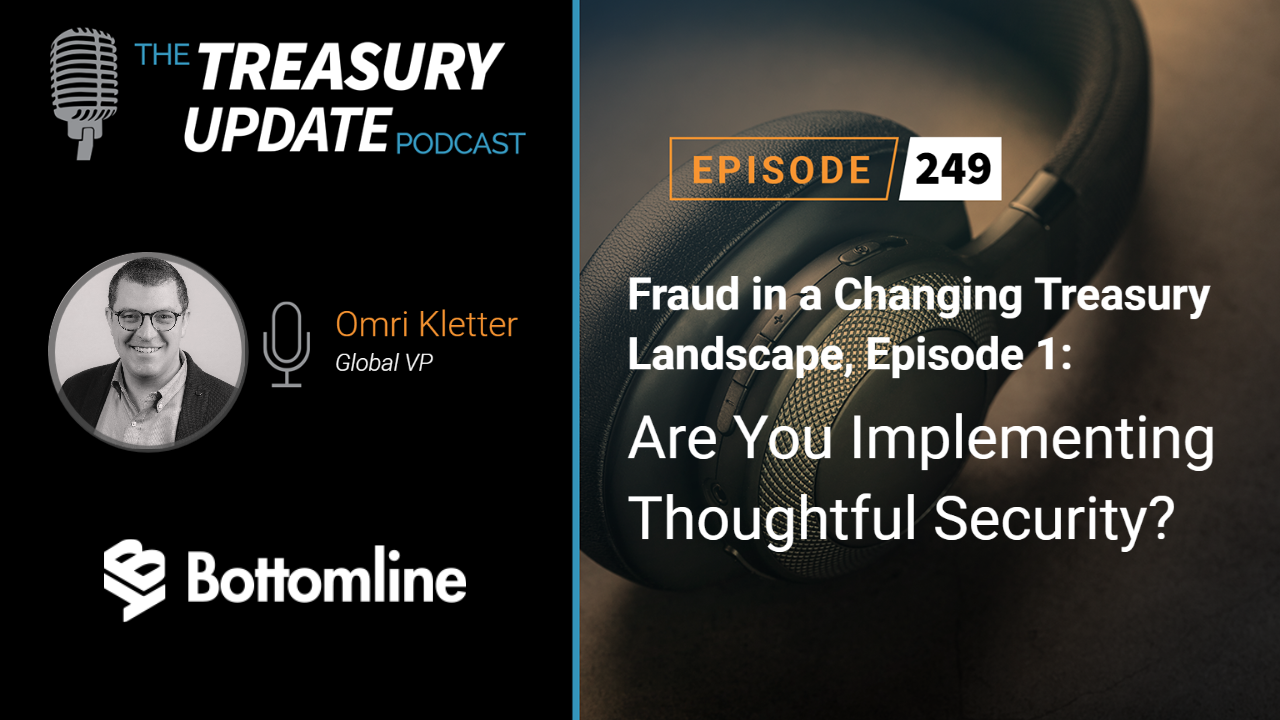
Episode 260
Learning from Financial Fraud Series, Episode 1: Unveiling the Parmalat Fraud Scandal and Bankruptcy
Welcome to the Learning from Financial Fraud Series, where we will explore multiple major financial frauds and thefts to see how each one occurred, was kept hidden, and was eventually discovered. Today we are exploring one of the largest financial scandals in Italian history, the Parmalat fraud case. This scandal led to the Italian dairy and food company’s 2003 bankruptcy. Discover how the fraud occurred, its impact, and learn preventive measures. Join Jason Campbell and Craig Jeffery as they discuss some of the key points behind this significant corporate fraud.
Host:
Jason Campbell, Strategic Treasurer


Speaker:
Craig Jeffery, Strategic Treasurer


Episode Transcription - Episode #260 - Learning from Financial Fraud Series, Episode 1: Unveiling the Parmalat Fraud Scandal and Bankruptcy
Announcer 00:04
Welcome to the Treasury Update Podcast presented by Strategic Treasurer, your source for interesting treasury news, analysis, and insights in your car, at the gym, or wherever you decide to tune in.
Jason Campbell 00:18
Welcome to the Learning from Financial Fraud Series on the Treasury Update Podcast. In this series, we will explore multiple major financial frauds and thefts to see how each one occurred and was kept hidden for a period of time. And we’ll dissect how it was eventually discovered and get insight and guidance on how to prevent this type of situation from happening and other companies or your company. I’m Jason Campbell, the host of this episode, and I’m joined with Craig Jeffery, managing partner and founder of Strategic Treasurer. So let’s begin with this first episode in the series and talk a little bit about the Parmalat fraud. Now Parmalat was an Italian dairy and food company that experienced a pretty significant fraud case that kind of led down to the bankruptcy back in 2003. So Craig, welcome to the show, you know, looking forward to hearing about this in this particular episode. And let’s kind of kick it off by going into exactly, can you detail us out, what was the situation with Parmalat?
Craig Jeffery 01:11
Well, I’m pretty excited about this series. I think there’s so much that can be learned by financial frauds that have occurred. And they give us real life examples of how fraud has gotten past some of the controls that existed there. But But to your question about what’s the situation with Parmalat what happened back then, you know, in 1999, everything started getting discovered and they ended up filing for bankruptcy in 2003. So this is a long time ago. But this is definitely one of the largest corporate frauds in history. Massive on a scale for for Italy, the situation was all kinds of financial misstatements, creating fictitious transactions, creating fictitious balances and accounts. really significant. Overall, the total loss was around 14 billion euros. One of the losses was related to a $4 billion dollar over 4 billion US dollar overstatement on a bank account, and they falsified audit records. And that’s a really interesting story about how they did that. But this is a this was a real significant situation. When auditors are checking they’re checking to make sure you have your the assets, the assets or you know, physical assets or their cash in bank accounts. The $4 billion was not in the accounts that they talked about. But they were able to get the get a fictitious certification on those accounts. How that worked is they they created and said, in the books of the organization that they had about $4 billion US in the account. The auditors prepare the statements and documents that they’re going to send to the bank for validation. What happened was, the Parmalat people were that were working with them said, Oh, we can have our assistant mail those out for you. So you don’t have to go post it. And they somehow took them up on that offer, which is surprising to me. Right? You have to have a separate and independent method of handling that. Well, they took those verification letters, and they verified them themselves and sent it back so that the auditors received confirmation that they had 4 Billion US that didn’t exist. So falsifying records and then falsifying the records used to validate or verify those balances what what happened. So it’s, it’s really pretty amazing how they did this. And it wasn’t it wasn’t that they did it only by setting up an account, they created a huge network of different subsidiaries, organizations created in the books of the organization, fictitious transactions, they had and show different types of revenue streams that would give rise to the assets they had. They also issued bonds to support everything that went on. So it looked like it was a very active, well performing business. But this was a this was a significant, significant challenge. And, you know, there’s a couple of those core issues, you said, what was the situation? Well, there were a lack of a number of controls both inside the company. And there was collusion within the company. And then there was lack of good controls on the outside of the organization as well.
Jason Campbell 04:20
I’m gonna be talking about four years in the making, right, of things that were going on, but I don’t know about anybody else but I’m thinking about 4 billion, right, 4 billion USD dollars. That’s just a lot of money that just to not have a grip on or a full understanding and from a standpoint of the the reporting and the lack of control in this situation, obviously was I mean, obviously the end result was devastating to the to that company, but just knowing that, you know, how somebody for four years was able to kind of have this mastermind of how this process was working out to defraud the company, which is absolutely insane.
Craig Jeffery 04:59
Yeah, so to that, you know, what was it? What were some of the things that triggered its discovery? Well, in December of 2003, they weren’t able to make bond interest payments. So they were able to create this, these fictitious transactions, subsidiaries create this great level of complexity and generate what looked like significant assets. And so they could raise funds, they were also borrowing funds. And so everything worked well, until it didn’t, they were no longer able to pay for those bond interest payments. When you think about that, you’re just paying interest, you’re not paying the debt back. And so that triggered some significant suspicion, because if this organization is doing so great, how can they not pay the interest? And so the whole house of cards fell apart. It wasn’t like they were bumping along, they were doing fantastic or so it looked. And that triggered all kinds of research in the media, by investors and different creditors. And then, you know, through that process to the Grant Thornton discovered some, hey, there’s some discrepancies on what’s going on two accounts, it doesn’t match what’s in the book, what’s on what’s on the bank doesn’t match in the book. And this is where they eventually unraveled the whole scheme. But that issue of falsifying confirming statements from the auditors certainly bought them more time, because that would have discovered, hey, there’s 4 billion missing here. And they were able to delay that
Jason Campbell 06:18
On just going off from a delay in perspective. Now, obviously, you know, the discovery to this and having, you know, that importance of having an outside independent partner coming in and being able to really go through the books to find those discrepancies to kind of, you know, say they said, there’s smoke, there’s fire, right. And so to really try to find out the specifics on what’s going on, and and be able to have that that discovery, I’m sure, you know, obviously, the investors would have loved to have had it earlier, you know, sooner rather than later. But, you know, obviously, the timing wasn’t exactly ideal, but at least you know, you know, getting to knowing what’s going on, as they were missing those, those those bond interest payments. So talking about now that we have what led to the discovery, I guess the big thing is, you know, what was the result? We had the discovery now. What what happened because of that?
Craig Jeffery 07:05
Well, there were arrests, there was the filing of bankruptcy by the company. I think it was 10s of 1000s. I’m not sure the exact number, but 10s of 1000s of employees lost their jobs. And then there was a lot of losses on the investor side. In addition, there was there was additional concerns. I mean, anytime a significant event happens, people are like, what’s going on with this particular country? Whether in this case is Italy or the US or Germany, there’s, there’s concerns, there’s loss of confidence in how, how is everybody being governed in these particular countries? Why? Why wouldn’t the controls catch it? So those are some of the most significant items.
Jason Campbell 07:44
So when we think about like, you know, I guess now, for those who are listening and thinking about, you know, I don’t think that can happen to me, right, anything is possible, right? Anything from a standpoint of we talked about criminal masterminds, as the sophistication, you know, the the technologies, the way that data is transferred, I mean, there’s a lot of potential vulnerabilities and a lot of systems, companies, organizations, if not having the proper controls in place. So kind of let’s talk about now that we’ve kind of exposed this particular fraud case, and that the magnitude of it, what are some some some ways that this type of fraud could have been or maybe in potentially just to prevent it from occurring in somebody’s organization?
Craig Jeffery 08:26
Yeah, so in this case, there’s there’s quite a bit that we talked about, I’ll limited to three. So first is your independent auditors, your external independent auditors need to be truly independent. They shouldn’t rely on someone else to mail out confirmations. That’s, that certainly is very obvious, just from our discussion. So that’s, that’s the free one. The second one is, you know, organizations should have a systematic internal audit of accounts. Whether this is done by the internal audit department, or, you know, even a third party on behalf of treasury, for example, this systematic audit of accounts. Where our accounts? What our balances in those? Validation of who can sign. That type of activity is essential. And I think it’s a, it should be for pretty standard for organizations above a certain size, let’s say, above a billion or two, in annual turnover. Third, when we think about full daily visibility to cash on a global scale, this is the standard of good corporate conduct this is commercially reasonable. You should be able to see all of your cash every day on a global basis. If you have accounts, your cost of doing business is having access to that. That should all be reported on a daily basis, not recorded by paper statements that roll in on the 10th or 15th that may get entered in an accounting system way late that can be easily forged. That should be digital, daily visibility on a global scale. This eliminates blind spots, and that certainly would point out, not the 14, not even the 14 billion euros or even the 4 billion US dollars in that one account. would show and detect that much, much sooner. And then at a proportional level with other organizations, so this helps eliminate blind spots. Jason, you know, many, many organizations have what they call like a cash report, a flash cash report, they come up with some creative name that shows, where’s our cash globally? What banks, what entities, what currencies? How is that changing over time, that provides a real focused view of what’s happening on the cash basis. Now, there’s always this challenge of, we don’t want everybody in the organization to know everything that’s going on, you certainly don’t want everyone in the organization to know the profit or loss or what’s occurring throughout the month, right to get that type of information. So there’s an aspect of limiting what’s known as financial information. But certainly, it shouldn’t be limited to just a few people on knowing where all the cash is. That should be treasury groups should know that. That should be known to the senior executives. So if you were to try to do collusion, or have to be to a massive number of people to say, here’s what here’s where our cash is, why is it changing so dramatically? Did we just issue, you know, $10 billion worth of bonds that we have a influx from? Why is it changing over time? So, full daily visibility, systematic internal review, and validation of accounts, and then truly independent, third party audits.
Jason Campbell 11:18
And as you were talking about these pieces, you know, it goes back to, you know, it’s trust, but verify, right? And having those control things in place. As you said, the multiple layers. You know, whether it’s multiple signers, or whether it’s, you know, multiple folks who have access to the visibility shouldn’t be unlimited, shouldn’t be a secret from a simple fact that locked in a vault by one person to tell to, you know, that one key is held to their heart, it should, there should be some place, you know, some some controls in place, or processes in place to ensure that there’s a grip on, you know, the cash flow. You know, as I always thought about in my time in my career always like that, from a standpoint of somebody who has some ill intent to cause a fraud or theft, right? It’s usually because they try a little, because they’re wanting to see how well you’re on top of things. What are your processes? Where’s the vulnerabilities? Is it is it, you know, the actual human vulnerability? Or is it a system or process vulnerability? And always think about that, that the may start off by taking the dollar right? $1 to see if anybody’s going to any alarms are going to be triggered, any noise is going to be had. And then the next go around, it’s a $5. It’s a 10, then it’s, it’s the big one, right? Then it’s $4 billion. Because you realize that you’re there, they’re able to penetrate and not have the alarm go off. And I think sometimes we kind of trust too much and not verify enough, you know, to make sure that what we have is safe and sound to prevent, you know, whether your organization from not being the next Parmalat and making sure that you know that the you’re not losing $4 billion out to somebody.
Craig Jeffery 12:51
Yeah, so yeah, the 4 billion US dollars can lead to 14 billion euros equivalent across the entire organization. So it certainly scales. And you know, the trust but verify. The Reagan, you know, quote, trust but verify. You know, the see and verify is what we’re talking about here. You need to be able to see it, see where your cash is, currency, bank, etc. And then that should be able to be verified both by treasury as well as by independent areas. So those are those are all appropriate warnings to people.
Jason Campbell 13:22
Well Craig, thanks so much for the discussion and hopefully our audience takes some of this to heart especially as this real case study of Parmalat and you know, the situation and their fraud case and you know, kind of how it happened and what the consequences that occurred after that. For our listeners, thank you so much for joining us today on this series of talking about learnings from financial fraud. Hopefully you enjoyed this episode here and then look forward to having you on our next episode as we discuss a another fraud case. Until next time, take care.
Announcer 13:52
You’ve reached the end of another episode of the Treasury Update Podcast. Be sure to follow Strategic Treasurer on LinkedIn. Just search for Strategic Treasurer. This podcast is provided for informational purposes only, and statements made by Strategic Treasurer LLC on this podcast are not intended as legal, business, consulting, or tax advice. For more information, visit and bookmark StrategicTreasurer.com.








